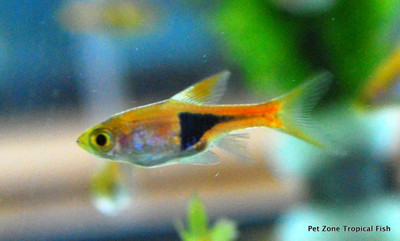Harlequin Rasbora
Posted by Max Gandara on on 8th Jun 2025
Harlequin Rasbora: The Jewel of Peaceful Planted Tanks
In the world of freshwater community fish, the Harlequin Rasbora is a classic favorite — and for good reason. With its shimmering copper body and distinctive black wedge, this tiny fish is not only eye-catching but also peaceful, hardy, and full of personality.
Perfect for beginners and adored by experienced aquarists, Harlequin Rasboras add motion, elegance, and harmony to any planted aquarium.
Quick Overview
-
Scientific Name: Trigonostigma heteromorpha
-
Common Name: Harlequin Rasbora
-
Origin: Southeast Asia (Thailand, Malaysia, Singapore, Sumatra)
-
Size: 1.5–2 inches (3.5–5 cm)
-
Lifespan: 5–8 years
-
Temperament: Peaceful, social
-
Tank Level: Mid to upper
Appearance: Small But Striking
The Harlequin Rasbora is instantly recognizable thanks to its copper-pink body and the triangular black patch that extends from the dorsal fin to the base of the tail — the “harlequin” mark. The contrast between this black wedge and the metallic sheen of its body makes it a standout, especially in planted or dark-substrate tanks.
-
Body Shape: Laterally compressed and streamlined
-
Sex Differences: Females tend to be slightly larger and rounder; males often have more vibrant coloration
-
Color Tip: Their iridescence intensifies under good lighting and with proper diet
Ideal Aquarium Setup
Harlequin Rasboras thrive in aquariums that replicate their natural Southeast Asian habitat — soft water, low light, and plenty of plants.
Tank Size:
-
Minimum: 10 gallons (for a small group)
-
Recommended: 20 gallons or more for a full school
Water Parameters:
-
Temperature: 72–80°F (22–27°C)
-
pH: 6.0–7.5
-
Hardness: Soft to moderately hard
-
Lighting: Moderate to low
-
Substrate: Dark sand or gravel enhances their colors
Decor:
-
Live plants (especially taller species)
-
Driftwood or branches
-
Leaf litter or Indian almond leaves (to mimic blackwater conditions)
? Pro Tip: A black background really makes their copper color shine.
Behavior and Compatibility
Harlequin Rasboras are schooling fish that should be kept in groups of at least 6–8 individuals — though a group of 10+ will look even more stunning and promote natural, coordinated swimming.
Temperament:
-
Peaceful and non-aggressive
-
Great dither fish that reduce shyness in other species
Ideal Tankmates:
-
Other small, peaceful fish like:
-
Neon tetras
-
Ember tetras
-
Corydoras catfish
-
Otocinclus
-
Dwarf gouramis
-
Cherry barbs (non-aggressive)
-
Shrimp and snails
-
Avoid larger, aggressive species or fin-nippers like tiger barbs.
Feeding and Diet
Harlequin Rasboras are omnivores and not fussy eaters, making them easy to care for.
What to Feed:
-
Staple: High-quality flakes or micro pellets
-
Supplements: Frozen or live daphnia, bloodworms, brine shrimp
-
Occasional Treats: Blanched spinach or spirulina-based foods
Feed once or twice a day in small portions that they can finish in 2–3 minutes. A varied diet helps keep their colors rich and supports longevity.
Breeding Harlequin Rasboras
Breeding in home aquariums is very possible with the right conditions.
Breeding Setup:
-
Separate breeding tank (soft, slightly acidic water)
-
Temperature around 78–80°F (25–27°C)
-
Fine-leaved plants or Java moss for egg laying
Spawning Behavior:
-
Males court females with vibrant displays
-
Eggs are scattered on the underside of broad leaves
-
Remove parents post-spawning to prevent egg predation
-
Eggs hatch in 24–36 hours; fry swim free in about 3 days
Feed fry infusoria or commercial fry foods, followed by newly hatched brine shrimp.
Health and Maintenance
Harlequin Rasboras are hardy and forgiving of minor mistakes, which makes them perfect for beginners. Still, good maintenance ensures a longer and healthier life.

